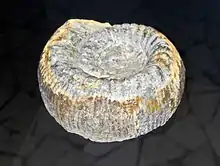Stephanoceratidae
Stephanoceratidae is a family of planulate and coronate ammonites within the Stephanoceratoidea.[1] Shells are evolute so that all whorls are exposed and have strong ribbing that bifurcates, that is splits in two, on the flanks. Many have tubercles at the point of bifurcation. Whorl sections are generally subequant; the outer rim, or venter, commonly rounded.[1]
| Stephanoceratidae Temporal range: | |
|---|---|
 | |
| Stephanoceras blagdeni from Mid Jurassic - Germany | |
| Scientific classification | |
| Domain: | Eukaryota |
| Kingdom: | Animalia |
| Phylum: | Mollusca |
| Class: | Cephalopoda |
| Subclass: | †Ammonoidea |
| Order: | †Ammonitida |
| Superfamily: | †Stephanoceratoidea |
| Family: | †Stephanoceratidae Neumayr 1875 |
| Subfamilies | |
|
See text | |
Stephanoceratidae is derived from the Otoitidae. Their fossils are found in upper Middle- and lower Upper Jurassic sediments.
Subfamilies and genera
- Cadomitinae
- Frebolditinae
- Garantianinae
- Mollistephaninae
- Stephanoceratinae
- Ermoceras
- Kosmermoceras
- Kumatostephanus
- Skirroceras
- Skolekostephanus
- Stemmatoceras
- Telermoceras
References
- Arkell, Kummel, and Wright, 1957. Mesozoic Ammonoidea; Treatise on Invertebrate Paleontology, Part L, Mollusca 4.
This article is issued from Wikipedia. The text is licensed under Creative Commons - Attribution - Sharealike. Additional terms may apply for the media files.